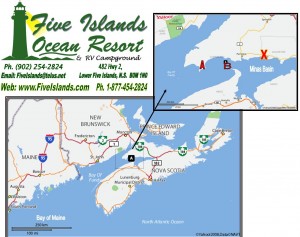




The Five Islands area is situated at the western edge of Colchester County, near the County of Cumberland, in the heartland of beauty and adventure of Northwestern Nova Scotia.  Renowned for the world’s highest tides and cherished for its scenic red rock cliffs, bountiful waterfalls and amazing geology and fossil finds, the area is a jewel of a find for adventure hounds and for those with an eye for beauty alike. Whether you are situated in a waterfront site that offers the sound of gently sloshing waves and the opportunity to slip your kayak in the water and paddle away or enjoying the spectacular view from your site elsewhere in the park, you can choose to witness the amazing Fundy tides right from your campsite or comb the beach for the treasures it offers…everything from clams to jewels to fossils.
Renowned for the world’s highest tides and cherished for its scenic red rock cliffs, bountiful waterfalls and amazing geology and fossil finds, the area is a jewel of a find for adventure hounds and for those with an eye for beauty alike. Whether you are situated in a waterfront site that offers the sound of gently sloshing waves and the opportunity to slip your kayak in the water and paddle away or enjoying the spectacular view from your site elsewhere in the park, you can choose to witness the amazing Fundy tides right from your campsite or comb the beach for the treasures it offers…everything from clams to jewels to fossils.
The Bay of Fundy: Tidal Forces
The Minas Basin, off the Bay of Fundy, is home to the highest tides in the world, and for a lot of reasons!
Tides are caused by the gravitational pull of the sun and the moon on the earth’s oceans, and in the Bay of Fundy, these forces combine with a variety of other factors to create the highest tides in the world. Not only can high tides reach as high as 60 feet or more above low tides in some areas, but more water rushes in and out of the Bay of Fundy twice a day than the volume of all the rivers of the world combined. There are two high tides, and two low tides per day, the high and the low separated by about 6 hours and 13 minutes. This is because it takes 24 hours and 52 minutes (that is, 4 groups of 6 hours and 13 minutes) for the moon to complete one orbit of the earth; this is one “lunar day”. The extra four groups of 13 minutes over a 24 hour “earth day” can be added together to explain why the water is at its highest and lowest about an hour later each day—scientifically, this is because, with the earth rotating on its axis in the same direction in which the moon is orbiting, it takes one full lunar day for the moon to complete its revolution so that a point on the earth can reappear directly beneath the moon…about one hour later in each da y here on earth. This is just one example of the amazing interconnectedness in the wondrous web of natural forces!!
y here on earth. This is just one example of the amazing interconnectedness in the wondrous web of natural forces!!
In the Bay of Fundy area, as the moon and the sun exert their pulls, water from the Bay of Maine is forced northwest along the shoreline into the shallower, landlocked Bay of Fundy. Compressed between funnel shaped and ever shallower shorelines, the water is forced with increasing velocity to Cape D’Or (“A” on map), where the current forks into two branches, the northern portion fills the Chignecto Basin while the southern half rushes onward through the narrow entrance to the Basin of Minas, home of the highest tides in the world.
This is because these water must be squeezed past the constricted opening between Cape Split and Blomidon (B), where the swirling, eddying, foaming tide attains a velocity of ten miles or more an hour. This exaggerates the effect of the twice a day flow of the tide as does the ever narrower, ever shallower channel the water is pushed further and further along. This is the general mechanism behind the Fundy tides, though local conditions determine great diversity in the height, velocity and specific effects. As previously stated, in some places, the extreme elevation of the flood tide above low water mark can be as great as sixty feet; in some rivers, the upward flow against the fresh water current forms a rapidly moving wall of water several feet in height—the tidal bore–the rushing sound of which can be heard at considerable distance. One tidal bore can be seen at the Board Landing Bridge in Truro, a mere forty five miles east of Five Islands.
These amazing tidal phenomena are a “must see” in experiencing Nova Scotia…and nothing can top off a day of viewing the incredible majesty of nature or partaking in any of the many other choices of leisure events in the area like enjoying the tranquility and friendliness of camping on the Five Islands shoreline that most travelers describe as one of the most beautiful locales in all of Nova Scotia.
Fossil and Rock Hounding and Our Amazing Geology
The Bay of Fundy is notable not simply for the billions of tons of water that have filled and emptied its shores twice each day for millions of years, but equally so for the superbly picturesque rock and cliff formations that have been whittled by wind and water over eons of time as well as the gr eat diversity, range and richness of geological evidence
eat diversity, range and richness of geological evidence
The Five Islands area is a gem of a find for rock-hunters and fossil seekers, largely because the entire Bay of Fundy area was once a part of Africa that drifted northward many, many millions of years ago, bringing with it many amazing geological wonders and spawning the formation of the Cobequid Mountains that both sculpted our shorelines and now shelter the site of Five Islands RV Campground from many a passing storm. Fossil fish finds have been discovered directly in the Five Islands area and, in 1985 the biggest fossil find of 200 million year old vertebrate dinosaur bones in all of North America was discovered in Parrsboro, a short drive down the road from us. Only minutes further down the road is the site of the Diligent River fossil find, revealing not only amphibian tracks but also a detailed record of life in the Upper-Carboniferous Period.
If rockhounding is more your style, you won’t need to go far. In fact, Moose Island, directly in front of the campground was a significant enough source of amethyst, Jasper and agate that it was featured in a David Suzuki TV special that reported on the amazing phenomena of this portion of the Fundy Basin. Even from the shores of Five Island RV Campground, sightseers can enjoy a view of spectacular red rock cliffs, and nearby treasures such as columnar basalts and faults are there for the seeker to enjoy; phenomena like the “Widow’s Peak” and the “Flowerpot” are also well worth the drive to explore and are just minutes away
Add to this the many museums, shops and shorelines to explore, and you’ll see that we are in the heart of history, in every meaning of the word!
More Recent “History”
The Five Islands area has a fascinating history, ranging from the stories and legends of its earliest inhabitants, the MicMac Indians, through the fact it is believed that Samuel de Champlain first set foot in North America on the shoreline a few miles down the road. Legend also has it that Captain Kidd left buried treasure on the islands when he was attacked while servicing his vessel in the bay. More recent still is the wealth of legend, tradition and romantic incident embodied in the early history of the people that dwelt in the area thereafter. For example, Sir Charles Tupper, Prime Minister of Canada for 16 days in 1896, once owned nearby Ottawa House just down the road in Parrsboro and the entire area is rich in architecture, beauty and an engaging history as one of the main port communities in all of Nova Scotia. 
Nowadays, Five Islands is a quiet community nestled between the sea and the mountains that offers relaxation and adventure galore for the seasoned traveler and local alike. Beauty abounds, and the waters beckon, twice a day inviting you out on their floor to explore, forage and enjoy. The highway in front of Five Islands RV Campground is aptly named “Waterfall Alley” thanks to the concentration of waterfalls that can be hiked into, with varying levels of difficulty. The area is blessed to be in the heartland of adventure and tranquility…strange bedfellows, indeed. The result it that there REALLY is something for EVERYONE to enjoy at Five Islands RV Campground.